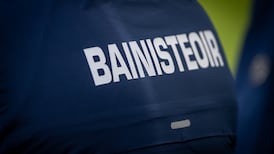This year has been no stranger to the GAA’s problem of short-termism, the process that inevitably accompanies attempted reform.
The opportunity to trial a restriction on hand-passing was squandered back in January despite its evidence-based credentials simply because it might entail temporary inconvenience.
The Chicken-Licken tendency has been out in force after the first few weeks of this year's hurling championship, with the sky apparently falling particularly hard in Munster.
There are valid reasons to be sceptical about the long-term prospects of the round-robin format but they largely relate to the lukewarm dependability of supporters when faced with any adversity, let alone serial failure.
The figures on that were well-known in advance. Writing about the overall concept of round-robin formats in his 2010 annual report, then director general Páraic Duffy pointed out the potential pitfalls.
“The effect of ‘round-robin’ groupings when used at club level, has been to diminish interest in the earlier rounds of competitions and to have a severely negative impact on attendances.”
Ironically, it was Duffy who devised the current football trial of round-robin All-Ireland quarter-finals – Super 8s, in the vernacular – but his argument was that the format would work differently when applied to the top teams in any given championship rather than to the popular concept of Champions League-style groups as a basis for an open-draw All-Ireland.
The jury is still out – or more accurately has yet to retire to consider a verdict – as we are just a year into the trial.
Last year’s evidence was inconclusive but the football round-robins did make it to the last weekend just about intact and so avoided the calamity of dead rubbers, which on the evidence of the hurling qualifier round robins in the middle of the last decade have the capacity to decimate – literally – average attendances: from 5,202 to as low as 218 and 310.
So the risks for hurling are there but so are the potential benefits, as could be seen last year.
Unlike the qualifier groups of the 2000s, which were operative from 2005 to ’07, the current provincial championships are an elite activity, contested by the top 10 teams in the country rather than those ranked five to 12. The former had the added disadvantage of the prospective top two being completely predictable over each of the format’s three years.
A bonanza
In the current structure, even with three progressing from both provinces there is a competitive edge as to who qualifies – for example All-Ireland champions Limerick had to be content with third place in Munster last year.
That competitiveness has played a major role in keeping attendances encouragingly high.
Last year showed that the new format was a bonanza for the Munster Council. The total attendance, including provincial final, came in at just under quarter of a million, 249,027 and an average of 22,639, against 127,997 and 31,999 respectively for the last year of the old system.
This represents nearly a doubling of the total and a decline of fewer than 10,000 in the average, excellent results given the allocation of so many fixtures to smaller county grounds that would usually not see major championship action.
And despite a considerable expansion of the fixture list and the fact that then counties had already met, the second successive Munster final between Cork and Clare was attended by a virtually identical crowd to the previous year, 45,363 as compared to 45,558.
In Leinster the figures were skewed by a provincial final replay but the improvement was as visible as in Munster: overall attendances up from 109,016 in 2017 – which included a record for the Galway-Wexford final – to 172,193. The average wasn't hugely affected by the near doubling of the number of fixtures: down from 18,169 to 15,654.
It is obvious that, to maintain these levels of engagement, neither province can afford for competitiveness to be compromised.
So far, indications are mixed. Waterford's problems became the weekend's story and Tipperary ran into yet another 'poor performance' by opponents, this time in Ennis and became the first Munster county to win three out of three in the format.
But both provinces have four counties still in contention for the top three spots and this year’s attendance figures are holding their own, more or less in line with last year’s and with a couple of big fixtures to come, such as Tipp-Limerick and Wexford-Kilkenny.
Tipperary's resurgence under Liam Sheedy is an illustration of how fortunes can change reasonably quickly – this time 12 months ago the county was heading for its earliest championship exit in 20 years.
Provincial ambitions
The rapid-fire schedule of fixtures means that momentum can change weekly: look at Cork in the space of the seven days that separated losing at home to Tipp and beating Limerick in the Gaelic Grounds.
Eamon O’Shea remarked some years ago that heavy defeats weren’t as debilitating in hurling because on a given day an out-of-sorts team can take a disproportionate hiding.
Limerick last year were whacked by 11 points in Ennis, calling a halt to any provincial ambitions, but put it behind them to build their best campaign in 45 years.
It may also be the case that the very format helps to equalise disparities by giving opportunities for home venues – allowing that in Munster five of this year’s opening six fixtures have been away wins but last year there was only one in the entire campaign and so far, over a championship and a half in Leinster, only Dublin of the ‘permanent’ counties have lost a match at home but just once.
As for the complaints about the television schedules, RTÉ aren't clairvoyants. There have been some cracking football matches in Ulster this season but given past experiences, how confidently can they be predicted when set against the quality of entertainment hurling has provided in the last year?
smoran@irishtimes.com












